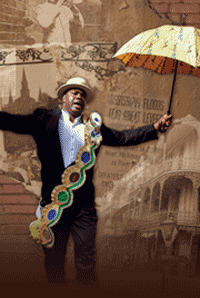
The “HELP US” signs, rescue boats cruising city streets, dead bodies, crying babies: In the year and half since Hurricane Katrina, New Orleans remains defined by the disaster which overwhelmed it in 2005. Now comes the PBS-produced New Orleans, which attempts to remind us of what made it special in the first place. Airing Monday, Feb 12, New Orleans has the unfortunate luck of coming on the heels of Spike Lee’s critically acclaimed documentary When the Levees Broke: Requiem for a City. But while Lee’s emotionally raw film laid bare the tragedy created by government inattention, “New Orleans” celebrates what has been jeopardized: the cultural and historical riches of the city.
Alternating between a history of the city, and scenes of residents struggling post Katrina, New Orleans speaks to the qualities that make New Orleans unlike any other city in the country (as one man puts it, outsiders are often referred to as “Americans”)while also arguing that the city produced many of the cultural products that made America itself distinctive.
The film juxtaposes these two ideas throughout. Quirky staples of New Orleans culture are highlighted: Mardi Gras, the tradition of picnicking in graveyards, its French sensibility. The film makes the point that New Orleans’ uniqueness made it “a radical experiment in American democracy” and that its diversity became a “vital creative force.” It was New Orleans’ population of free blacks—the most prosperous in the nation at the turn of the century—that met in the offices of the blacks newspaper “The Crusader” to shape the case that would eventually become Plessy v. Ferguson. And, as many have argued before, the city’s French, African, and Spanish roots helped create both jazz and Creole cuisine.
Yet, amid this celebration there is also the sense that something went terribly wrong. Despite having racially diverse neighborhoods as far back as the early 19th century, New Orleans became a hotbed of Jim Crow racism. When Louis Armstrong triumphantly returned to his hometown in the 1940s he was astounded by the degree of segregation in the city. He vowed never to return again, saying “honestly, they treat me better all over the world than they do in my own hometown.” In many ways, New Orleans, which in the 1920s had been called the place “where you could expatriate without going to Paris” became most conformist in its racial attitudes. White flight was especially severe, and by 2000 the city was 67 percent black, with 28 percent of those blacks living under the poverty line.
In post-Katrina New Orleans many of these contradictions are still evident. There are the white, stiff haired, lacquered ladies who participate in the yearly “Rex Ball,” donning corsets and gold ball gowns to reenact a medieval court. Seemingly sheltered from the tragedy that has struck their city, two of these women are shown rehearsing their regal duties, one reminding the other to “project to your audience.” But for most residents, the show has not gone on. Leah Chase proprietress of the culinary landmark “Dooky Chase” gives a tour of her decades-old restaurant, now ruined. While staring at her enormous, burned-out stove she boasts she cooked for everyone from Thurgood Marshall to Big Daddy Kane. She plans to rebuild, saying “We need to be here. We need to save our neighborhood.”
Even if the film exudes optimism for New Orleans’ future, an air of bitterness still lingers. While watching revelers prepare for Mardi Gras, a man shows the float he constructed with a sign reading “Buy Us Back Chirac!” and the camera frequently pans over scenes of barren, dilapidated neighborhoods.
The film’s combination of the historical and the contemporary is not always successful. Too often the switch from archival footage to current day scenes is disjointed. Other times, subjects are left hanging. We are told for instance, of the wood pumps first created at the turn of the century and the failure of the levees during the 1927 Good Friday flood, but not of what came in between, or immediately before 2005. Still, the homegrown talking heads who populate the film—writers, academics, musicians, painters—are moving in the pride and love they have for New Orleans. As writer Rick Bass explains, “When you move, the ground shifts under your feet. Makes no sense to want to own a piece of it, yet many of us do.”














